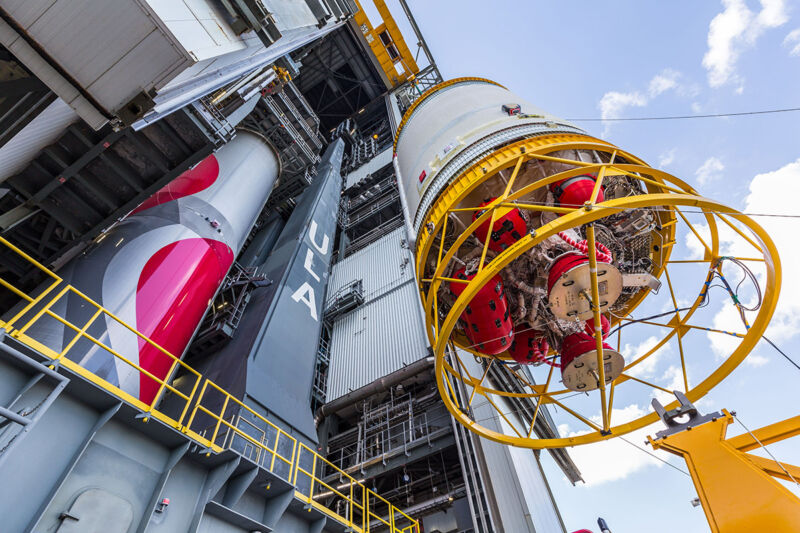
United Launch Alliance technicians at Cape Canaveral, Florida, have partially disassembled the first Vulcan rocket to send the launch vehicle’s upper stage back to its factory for reinforcements to its paper-thin steel fuel tank.
A test article for the Vulcan rocket’s Centaur V upper stage exploded on March 29 during a structural test at NASA’s Marshall Space Flight Center in Alabama. After a nearly three-month investigation, ULA engineers determined the upper stage already mounted to the first flight-rated Vulcan rocket inside a hangar in Florida needs more work.
ULA hasn’t ruled out launching the company’s first new Vulcan rocket by the end of the year, but the recovery from the test stand explosion in March eliminated any chance of getting Vulcan off the ground this summer. This also means the Vulcan rocket won’t become operational for the US military until some time next year, following two “certification” flights to demonstrate the vehicle’s performance and reliability.
The US Space Force is eager for the Vulcan rocket to enter service. The Pentagon selected ULA and SpaceX in 2020 to launch around 40 of the military’s most critical surveillance, communications, and navigation satellites from 2022 through 2028. ULA won the rights to launch about 60 percent of the missions, primarily using the new Vulcan rocket, with SpaceX taking the remaining 40 percent with its Falcon rocket family.
The Vulcan rocket will replace the Atlas and Delta launch vehicles flown by ULA, a 50-50 joint venture between Boeing and Lockheed Martin. Just one Delta rocket is left in ULA’s inventory before retirement, and 19 more Atlas V launchers remain in ULA’s backlog. All of those rockets are already reserved for customers.
Gary Wentz, ULA’s vice president for government and commercial programs, confirmed previous reporting from Ars that the first Vulcan launch is now targeted for no earlier than the fourth quarter of this year.
The Centaur V upper stage for the first Vulcan launch was de-stacked from the Vulcan booster to prepare for shipment back to the factory, according to Jessica Rye, a ULA spokesperson.
In a statement, ULA described the work needed on the Centaur V upper stage as “minor reinforcement at the top of the forward dome,” or the uppermost section of the liquid hydrogen tank. The changes will add strength to the tank, which contains super-flammable fuel chilled to minus 423° Fahrenheit (minus 253° Celsius).
Wentz said the March 29 test stand explosion was caused by a liquid hydrogen leak on the forward bulkhead of the Centaur V upper stage.
“Then what basically happened is we got a large concentration of hydrogen gas that found an ignition source outside of the vehicle and ignited,” Wentz said.
“The super thin, high performance steel skin needs to be a little thicker near the top of the dome,” tweeted Tory Bruno, ULA’s chief executive. The steel walls of the Centaur upper stage’s pressure-stabilized propellant tanks are as thin as 0.02 inches, or half a millimeter, in some places.
Wentz said the investigation concluded the problem is “relatively easy” to fix. ULA’s production team is readying another Centaur V test article at the factory in Decatur, Alabama, for a second attempt at the ground test cut short by the explosion in March.
Vulcan booster and payloads ready to go
In the meantime, ULA’s launch crew at Cape Canaveral will also remove the Vulcan booster stage from its launch platform and store it horizontally in another hangar until the company is ready to resume launch preparations. ULA plans to launch a pair of Atlas V rockets this summer and fall from the same launch pad that Vulcan will use.
ULA aimed to launch the first Vulcan rocket in 2019 when the company announced the program in 2015. Trouble with the development of the first stage’s new methane-fueled BE-4 engines, built by Jeff Bezos’s space company Blue Origin, has been responsible for most of the delay in the Vulcan’s inaugural flight.
But now the first stage, with two flight-ready BE-4 engines, is ready for launch. ULA test-fired the rocket on its launch pad in Florida on June 7, and the company says the “flight readiness firing” achieved all objectives.
The main payload for the Vulcan’s first launch is also complete and in storage until it needs to be trucked to Cape Canaveral. The rocket’s debut flight will send a commercial lander built by Astrobotic to the Moon with a package of experiments and tech demo payloads for NASA. Two test satellites for Amazon’s Kuiper broadband network will hitch a ride to space on the first Vulcan rocket.
It turns out the issue that’s now keeping Vulcan grounded is part of the rocket with a design rooted in the early years of the Space Age. The Centaur V is a larger, updated twin-engine version of the Centaur upper stage, which has flown on 268 missions since 1962.
"Factory" - Google News
June 29, 2023 at 12:50AM
https://ift.tt/G1OMZLy
ULA shipping Vulcan upper stage back to factory for more work - Ars Technica
"Factory" - Google News
https://ift.tt/q1pVL6H
Shoes Man Tutorial
Pos News Update
Meme Update
Korean Entertainment News
Japan News Update
Bagikan Berita Ini














0 Response to "ULA shipping Vulcan upper stage back to factory for more work - Ars Technica"
Post a Comment